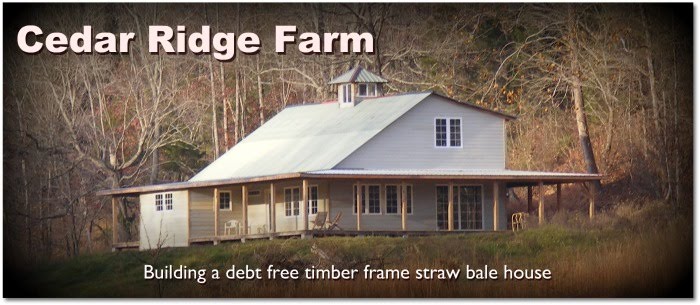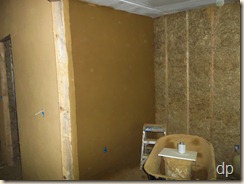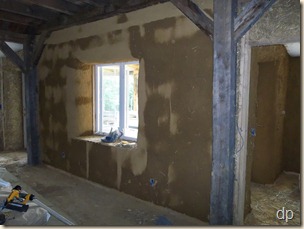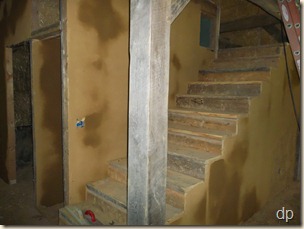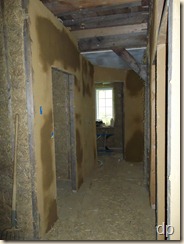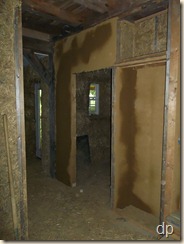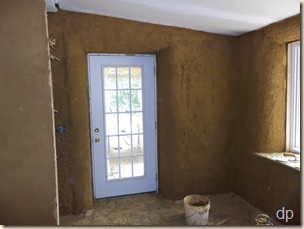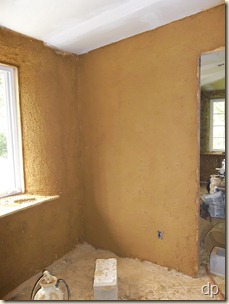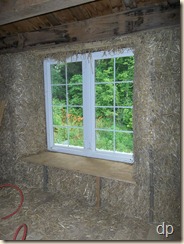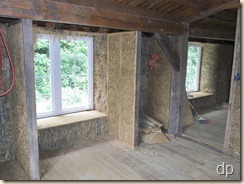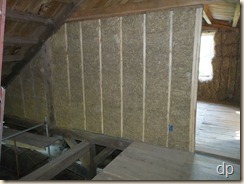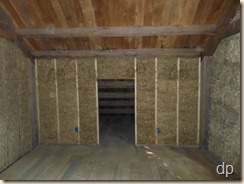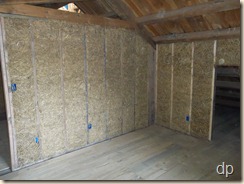There were several things to do this last week that did not involve the house, but we were still able to mix and apply several batches of plaster.
On Monday, the boys and I worked all day plastering the walls in the laundry room. We mixed seven batches of plaster and put them on the walls.  Each batch weighs around 240 pounds wet. Once it dries, it’ll lose about 40 pounds per batch (a five-gallon bucket of water). So, that’s 1,400 pounds of thermal mass on just these four walls alone. If we count all the walls we’ve done so far (including the walls we did on Friday that I haven’t mentioned yet), it figures out to about 3,500 pounds of thermal mass, and we’ve only put the first coat on a few of the walls. There is still the second coat on the straw bale walls to be figured and a finish coat on all the walls.
Each batch weighs around 240 pounds wet. Once it dries, it’ll lose about 40 pounds per batch (a five-gallon bucket of water). So, that’s 1,400 pounds of thermal mass on just these four walls alone. If we count all the walls we’ve done so far (including the walls we did on Friday that I haven’t mentioned yet), it figures out to about 3,500 pounds of thermal mass, and we’ve only put the first coat on a few of the walls. There is still the second coat on the straw bale walls to be figured and a finish coat on all the walls. 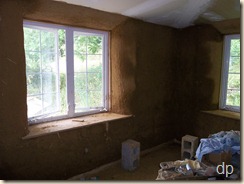 I find it interesting to think about the mass of the plaster that will help moderate temperature and humidity (clay is good for that) when the house is done.
I find it interesting to think about the mass of the plaster that will help moderate temperature and humidity (clay is good for that) when the house is done.
I took the photos today of the plaster we applied last week. So, you can see that it is drying nicely. It’ll be cured within the next week, I expect. The places where it is thicker will take longer to dry thoroughly, but there’s not really any hurry. The only concern is mold. If the weather cools off and it is damp, the plaster won’t dry quickly like it does when it is warm with a good breeze blowing through the house. We had a few areas on the 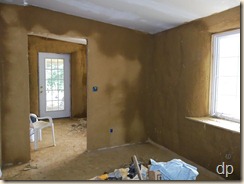 walls that we packed with slip straw last fall that grew some mold on the surface because the drying conditions deteriorated after we packed them.
walls that we packed with slip straw last fall that grew some mold on the surface because the drying conditions deteriorated after we packed them.
I’m not really worried about the mold. It seems to originate in some of the straw that is used in the mixes, probably because of the presence of mold spores. It can only survive and grow in moist conditions. I have discovered a safe way to kill it and prevent it from spreading – white distilled vinegar. We sprayed walls that grew mold after packing last year, and it took care of the problem. There have been a few places where some mold appeared on the surface of the plaster when the drying conditions 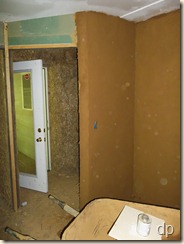 were not ideal recently. A little vinegar kills it quickly. I’m sure if it was a major case, not just a little here or there, that there might be some other remedies needed, but this one is working for us.
were not ideal recently. A little vinegar kills it quickly. I’m sure if it was a major case, not just a little here or there, that there might be some other remedies needed, but this one is working for us.
So, after doing all the walls in the laundry room, we didn’t get back to plastering until Friday. We only had the afternoon, and we worked in the guest room. We were able to get 2 walls done. We’ll finish this room tomorrow if all goes well. And, we’ll do a few more walls, too. It is reasonable for us to finish the first coat on all the downstairs walls this week.
